 Society
Society

 |
| An officer of the National Hydrometeorological Centre monitors weather developments. VNA/VNS Photo |
HÀ NỘI — The General Department of Meteorology has revealed that its early warning system has played a crucial role in mitigating the impact of extreme weather events and safeguarding both lives and property.
In its latest report, the department stated that it had issued over 58,600 forecast and warning bulletins to relevant authorities annually, facilitating disaster prevention and response efforts.
The report highlights the effectiveness of the meteorology industry, which was able to provide timely forecasts for seven storms, two tropical depressions, and a range of severe weather events, including cold spells, heat waves, and floods. These forecasts allowed for prompt action to be taken, reducing the risk of harm to communities and their livelihoods.
The agency has also well performed its role as a focal point for hazardous weather forecasting in Southeast Asia.
In 2023, it is forecast there will be 11-13 storms and tropical depressions in the East Sea, of which 5-6 storms will affect the mainland.
Heat waves this year are forecast to become more intense.
Deputy Director of the National Center for Hydro-Meteorological Forecasting Hoàng Phúc Lâm said the sector has extended the time limit for weather forecasting and early warning of natural disasters to 10 days.
The content and format of the bulletins have changed a lot, focusing on providing forecast information on a smaller scale at the district and commune levels, and over a longer time period.
Storm forecasts and tropical depression warnings are given three to five days in advance; heavy rain two to three days in advance, and thunderstorms from 30 minutes to two to three hours in advance. Severe and damaging cold spells are forecast two to three days in advance.
Trần Hồng Thái, general director of Việt Nam’s General Department of Meteorology, said the industry has strongly focused on investing in science and technology to promptly provide information and data, ensuring consistency, accuracy, continuity, reliability, effectively serving sectors and ministries.
He said climate change is expected to worsen the frequency, intensity and impacts of some types of extreme weather events.
Flash floods and landslides in mountainous areas; geotechnical data in the East Sea, along with the requirements for international cooperation, the country's socio-economic development activities in the context of the strong development of science and technology have been posing challenges to the meteorological sector.
Deputy Minister of Natural Resources and Environment Lê Công Thành requested the sector to implement solutions to comprehensive digital transformation urgently, continue to promote research and application of new technologies to collect and exploit information from satellites to meet the requirements of weather forecasts, especially storms, tropical depressions and monsoons.
The meteorology industry needs to improve the capacity and quality of forecasting to meet requirements in disaster prevention and socio-economic development amid climate change.
Human resource training is necessary, especially for teams specialising in forecasting the impact of issues relating to socio-economic development.
He emphasised that measures and solutions for detailed assessment of renewable energy potential for development are also needed, making an important contribution to Việt Nam's commitment to net zero carbon emissions by 2050. VNS




